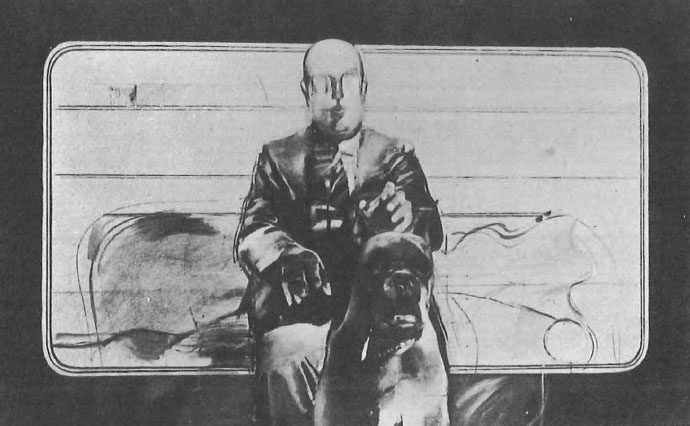The main body of the work was presented in the spacious Kolonaki Square gallery under the title of ‘Epitimvia’ which means literally ‘inscriptions on gravestones’.

The exhibition viewed as a whole was uniformly simple. Its thematic title bore direct relation to the form used by the ancient Greeks for their graves-tones, which consisted of a marble slab with relief carving. Mytaras has taken this motif and transferred it frankly and boldly to his canvases. Their compositions were simple, and although following closely the traditional ancient form, there was nothing funereal about these paintings, nor did they reflect morbid associations about death. The bright, uniform, flat, monochrome ground seemed, in fact, to project the figures forward and coincidentally deprived the works of spatial depth.
Striking features were the imposing, relief-like architectural frames of the paintings and, in contrast, the vitality of the sketch-like figures appeared very real. Mytaras astutely achieved this impression by painting part of the figure outside the architectural frame as seen for instance in ‘Yellow Epitimvio’.
The subjects revolved around solitary figures, men in leather jackets, bull dog& and motorcycles, all synonymous with violence. The overall mood of the exhibition was therefore one of oppressive violence and ensuing panic, fear and catastrophe. In ‘Man with Bulldog’ the intensity of this feeling was physically sensed. It is obvious that Mytaras is concerned with making a socio-political statement about the oppressor within the framework of power politics and the ever-present undercurrent of inevitable violence. In many of the paintings he has given the impression of great movement by articulating parts of the figures, dogs, or objects depicted. This gives vitality to the otherwise stereotyped compositions.
This articulated movement vaguely recalls Francis Bacon but without his confirmed sensuality.
On leaving the exhibition, it occurred to me that the inherent harmony of this exhibition, when viewed as a whole, could also be read as a uniform monotony. It seems that Mytaras may have fallen into a trap of the technique he employed, and his visual language in this instance suddenly appeared just a little sterile, as though he had overlaboured his point.







